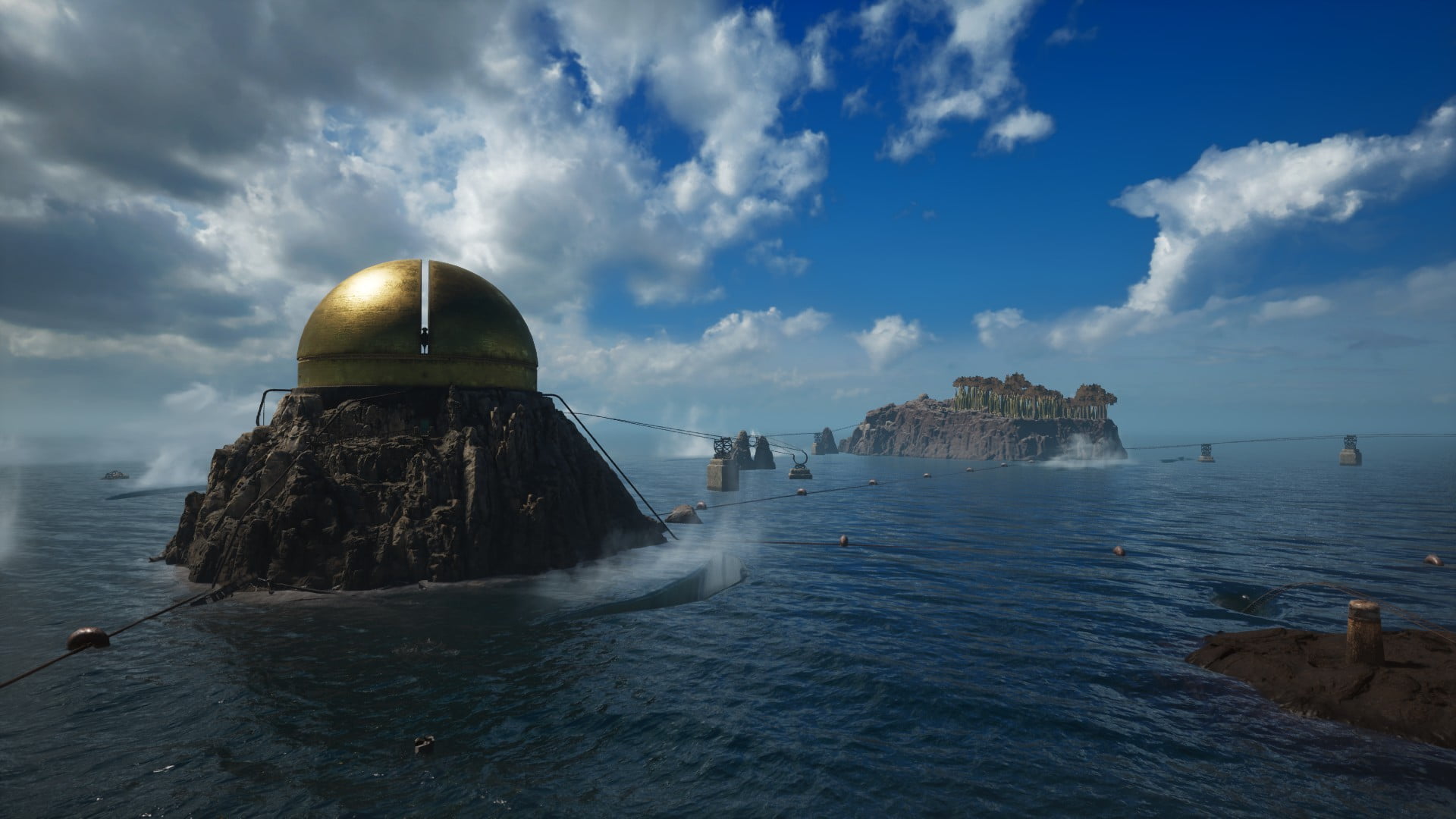For the past couple years, one of the best parts of E3 isn’t actually within the show itself. The Indie Media Exchange is a small invite-only event that roams the world as either a booth in various videogame conventions or as a supplementary event on the side. It was something of a surprise last year for us, a low-key event that took place not long after E3 proper closed shop for the day.
Like the IndieCade booth, the MIX is a nice change of pace from the usual E3 offerings. Instead of a crowded show floor rife with bright lights and loud music, the MIX was a small intimate event that took place on a rooftop in downtown LA. Tables with laptops and televisions lined the area, the developers all on-hand to show off their work. Games of every sort were on display, ranging from rapturous local multiplayer festivities to quiet introspective works. It was very busy – though compared to the packed halls of the LA convention center, it felt calm and open.
For folks like us, it was as much an opportunity to see some extra games as it was a chance to catch up with colleagues and generally relax. E3 isn’t a show that grants us time to rest; from the moment we wake till we go to sleep, we’re pretty much always working in some capacity. The MIX is one of the few moments during the show where we get to take it easy – even if it while we’re on the clock.
This year’s MIX venue was larger, but it nevertheless just as packed in terms of the attention everyone’s games were getting. As such, we didn’t get to see too many games (there are definitely a few I still regret not seeing), but what we did see where definitely worthwhile.
Narcosis
I was never very hot on the idea of Oculus Rift, but after a couple of E3s testing out some games that made interesting use of it, I’m just starting to grow on the idea of a virtual reality future for videogames. Narcosis was a neat surprise to run into while we were attending this year’s Indie Mix during E3.
As a horror game, Narcosis already works just based on its concept of forcing you to explore the ocean depths all by yourself, in an seemingly abandoned underwater research station. The immersiveness of Oculus only adds to the claustrophobic effect of wearing a deep sea diving suit, and is also extremely effective in a physical sense as well, closing in on your face and ears, like an actual suit would.
Sure, the demo I played had its share of pop up scary cliches, too. Like when I walked into a seemingly empty room, looking for air capsules for my oxygen supply, and then turning around, only to be surrounded by empty diving suits. These are given for a first person game like this that limits your peripheral view artificially for the sake of atmosphere, but here’s hoping the actual game will be a little more original.
Overall, the slice of game that the demo showed proved that Narcosis is an already incredibly impressive game on its own. With Oculus Rift, though, it works even better.
-Eduardo
Capsule Force and Videoball
Iron Galaxy had a trio of local multiplayer games to show off this year with Gunsport, Capsule Force, and Videoball. Of the three, I only got to see Capsule Force and Videoball, as Gunsport was dealing with some technical issues at the time. The two I did get to play, though, were some of the most fun I’ve had with local multiplayer games in some time.
Videoball pits two teams of two against one another as they attempt to direct balls toward the opposing team’s goal. You pilot a small triangular ship around a nondescript sports field and fire bullets of varying sizes both toward the ball and your opponents. The game is viewed from a top-down perspective and plays like a dual-stick shooter, every button and trigger on the controller firing shots in place of the right stick, which controls your aim.
Chaos consumes Videoball in almost no time at all. It starts by dropping one, maybe two balls into the arena. They’re large and weighty, taking considerable effort to push around. Small shots barely make a dent, while fully charged bullets send it speeding around the area uncontrollably. Taking the time to charge up shots leaves your goals open, however, so the game quickly devolves into a scramble to protect your goal while still trying to score points. Different fields further complicate matters by making the goals bigger or smaller or walling off sides of the arena.
Capsule Force also pits two teams of two against one another, only here, you’re fighting to push one of two platforms toward the left or right side of the screen to grab that team’s capsule. Think Nidhogg were it a four-player game and if you had guns instead of rapiers. It’s a dual-stick game, only this one is a side-scroller instead of isometric.
Where Videoball was chaotic on virtue of scale, Capsule Force is chaotic due to its speed. Right from the word go, every match erupted into pure anarchy. Lasers filled the screen as we started firing left and right, jumping about the screen trying to avoid each other’s firepower while trying to move those platforms. It all happened so quickly it’s a wonder any of us could keep up. The mayhem only doubled once we moved to some of the more complex stages. Pitfalls, barriers, lasers – it all serves to make the action even more absurd.
Videoball is out sometime this summer on PlayStation 4, Xbox One, and PC, and Capsule Force is out in August for PlayStation 4 and PC.
-Callum
Bunker Punks
A first-person shooter meets base-management in the form of a rougelike, Bunker Punks is a game wherein you steal from the rich to sustain yourself. The world is run by corporations following a series of events that led to something called “the fall.” It works like this: You perform raids on various institutions – be they offices, hospitals, or so on – to gather supplies. With those supplies, you upgrade your base and help the resistance grow.
When on one of these raids, the game turns into a first-person shooter. You run around a series of procedurally generated rooms fighting off security bots and sentries grabbing whatever supplies you can find, climbing higher and higher through the building until you reach the top floor. Then you have to choose whether to return to base or keep going and assault a different complex. The base management portion is similar to something like XCOM. You have a set number of rooms and have to decide which ones to refurnish. Adding more beds can allow new members to join your ranks, whereas upgrading surveillance tech allows you get more information on potential targets.
It presents a tough balance. You need to steal to earn supplies to strengthen the resistance, but you need to also expend those supplies in the field to help you earn more. (Using bullets to earn more bullets, for instance.) It makes you think about tactics in ways you don’t expect to in a shooter. Usually the only thing that matters is being able to shoot with precision and not get shot yourself in the process. Here, it’s more about resource management.
I didn’t pick up on that immediately, though, because I was already in the midst of a raid when I started playing. Because shooter portion is fast, both in general movement speed and the pace of combat, I played it as I would something like Doom: constantly moving and shooting without much care for ammo conservation. Spare bullets were hardly scarce, anyway, so whatever. I could get more. But I merely got lucky on that first run. Next time I left the bunker, things turned dire in no time. I went from having a decent stock of ammo to none at all in the span of a single floor. And since I chose a hospital, there were no bullets to be found. I had plenty of medical supplies, but nothing with which to defend myself. It was basically game over at that point.
Bunker Punks doesn’t have a release date yet, though the game is available for pre-order via its website.
-Callum
SMS Racing
Given all the evangelizing about virtual reality at E3 this year, how much it’s supposed to change videogames and how we engage with them completely, SMS Racing may not seem like the most prime example of VR’s potential. Originally a game jam project, it’s a racing game where you attempt to win a race while texting with your friends. Silly, right? Yeah. But as my first experience with VR, it helped me understand the appeal.
The game began by dropping me into a race set in a city. My left hand was on the wheel while my right sat in my lap holding a phone. Every few seconds a text would arrive. If I didn’t respond in ten seconds, I’d lose that person as a friend, because that’s how friendships work. Texts are sent by typing one of four letters with the face buttons of a controller. The texts are quick and often nonsense; acronyms and allusions toward previous conversations make up the majority of the back-and-forth.
My view was limited, though I was able to easily move my head into a position where I could easily swap between the road and the phone just by moving my eyes slightly. Felt pretty good about it at first since it appeared that I would be able to jump between the road and the phone with ease. I could just rely on my peripheral vision to keep an eye on the road whenever I had to respond to a text. Or so I thought. Had I been playing on a monitor, that might have worked. But since I had a headset on, my view was far more narrow. Peripheral vision doesn’t help at all as I could only see whatever my eyes were directly focused on. Didn’t help that my vision was impaired due to not being able to wear my glasses while using the Gear VR. Meant I had to squint to get a clear image.
I tried to multitask, but the nature of viewing the game through a headset wasn’t conducive. I tried making sure I was on a straight stretch of road before answering a text, but I could never count on them arriving at those opportune moments. They usually came in right as I approached a turn, resulting in my car crashing into a wall for most of the race. But since I already fell behind at the start (didn’t realize I had to hold down the right bumper on the controller instead of the trigger), I stopped caring about winning. Was more interested in simply finishing it.
It sounds obvious in retrospect, but it’s surprising how much something as simple as how we view games completely changes how we engage with them. Reading about all the impressions of various VR devices over the past couple years, I thought I had a good grasp of it. Using it for myself, however, really drives home how important it is to try it for yourself to understand it. It’s a truly fascinating concept. SMS Racing may not be one of those VR experiences that redefines videogames, but it’s a fun demonstration of the tech all the same.
-Callum









